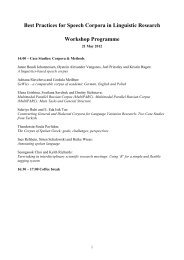96 • 2011 - Hamburger Zentrum für Sprachkorpora - Universität ...
96 • 2011 - Hamburger Zentrum für Sprachkorpora - Universität ...
96 • 2011 - Hamburger Zentrum für Sprachkorpora - Universität ...
Create successful ePaper yourself
Turn your PDF publications into a flip-book with our unique Google optimized e-Paper software.
Multilingual Resources and Multilingual Applications - Invited Talks<br />
Constructing parallel lexicon fragments based on English FrameNet entries:<br />
Semantic and syntactic issues<br />
Hans C. Boas<br />
The University of Texas at Austin<br />
Department of Germanic Studies and Department of Linguistics<br />
1 University Station, C3300, Austin, TX 78712-0304, U.S.A.<br />
E-mail: hcb@mail.utexas.edu<br />
Abstract<br />
This paper investigates how semantic frames from FrameNet can be re-used for constructing FrameNets for other languages.<br />
Section one provides a brief overview of Frame Semantics (Fillmore, 1982). Section 2 introduces the main structuring principles of<br />
the Berkeley FrameNet project. Section three presents a typology of FrameNets for different languages, highlighting a number of<br />
important issues surrounding the universal applicability of semantic frames. Section four shows that while it is often possible to reuse<br />
semantic frames across languages in a principled way it is not always straightforward because of systematic syntactic<br />
differences in how lexical units express the semantics of frames. Section five summarizes the issues discussed in this paper.<br />
Keywords: Computational Lexicography, FrameNet, Frame Semantics, Syntax<br />
1. Frame Semantics<br />
Research in Frame Semantics (Fillmore, 1982; 1985) is<br />
empirical, cognitive, and ethnographic in nature. It seeks<br />
to describe and analyze what users of a language<br />
understand about what is communicated by their<br />
language (Fillmore & Baker, 2010). Central to this line<br />
of research is the notion of semantic frame, which<br />
provides the basis for the organization of the lexicon,<br />
thereby linking individual word senses, relationships<br />
between the senses of polysemous words, and<br />
relationships among semantically related words. In this<br />
conception of the lexicon, there is a network of<br />
hierarchically organized and intersecting frames through<br />
which semantic relationships between collections of<br />
concepts are identified (Petruck et al., 2004). A frame is<br />
any system of concepts related in such a way that to<br />
understand any one concept it is necessary to understand<br />
the entire system; introducing any one concept results in<br />
all of them becoming available. In Frame Semantics,<br />
word meanings are thus characterized in terms of<br />
experience-based schematizations of the speaker's<br />
world, i.e. frames. It is held that understanding any<br />
element in a frame requires access to an understanding<br />
of the whole structure (Petruck & Boas, 2003). 1 The<br />
following section shows how the concept of semantic<br />
frame has been used to structure the lexicon of English<br />
for the purpose of creating a lexical database.<br />
2. The Berkeley FrameNet Project<br />
The Berkeley FrameNet Project (Lowe et al., 1997;<br />
Baker et al., 1998; Fillmore et al., 2003a; Ruppenhofer<br />
et al., 2010) is building a lexical database that aims to<br />
provide, for a significant portion of the vocabulary of<br />
contemporary English, a body of semantically and<br />
syntactically annotated sentences from which reliable<br />
information can be reported on the valences or<br />
combinatorial possibilities of each item targeted for<br />
analysis (Fillmore & Baker, 2001). The method of<br />
inquiry is to find groups of words whose frame<br />
structures can be described together, by virtue of their<br />
sharing common schematic backgrounds and patterns of<br />
expressions that can combine with them to form larger<br />
phrases or sentences. In the typical case, words that<br />
share a frame can be used in paraphrases of each other.<br />
The general purposes of the project are both to provide<br />
1 See Petruck (19<strong>96</strong>), Ziem (2008), and Fillmore & Baker<br />
(2010) on how different theories employ the notion of “frame.”<br />
9



